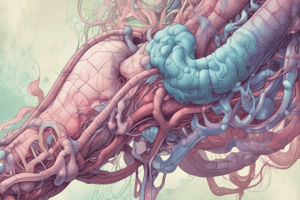Podcast
Questions and Answers
What is the main organ involved in human respiration?
What is the main organ involved in human respiration?
lung
During inhalation, the diaphragm muscles ______ and ______ to increase the volume of the thoracic cavity.
During inhalation, the diaphragm muscles ______ and ______ to increase the volume of the thoracic cavity.
contract, flatten
Which of the following adaptations of the alveolus facilitate gas exchange?
Which of the following adaptations of the alveolus facilitate gas exchange?
- Moist wall (correct)
- Small size and high number present (correct)
- Thick wall
- Rich supply with blood capillaries (correct)
The partial pressure of O₂ is higher in blood capillaries than in tissues.
The partial pressure of O₂ is higher in blood capillaries than in tissues.
What percentage of O₂ in blood is transported by haemoglobin?
What percentage of O₂ in blood is transported by haemoglobin?
What controls the rate or speed of breathing?
What controls the rate or speed of breathing?
CO₂ diffuses into the _______ during exhalation.
CO₂ diffuses into the _______ during exhalation.
What form does carbon dioxide take when it combines with haemoglobin?
What form does carbon dioxide take when it combines with haemoglobin?
The Medulla Oblongata controls nonrespiratory air movements.
The Medulla Oblongata controls nonrespiratory air movements.
What is the primary purpose of the respiratory control system?
What is the primary purpose of the respiratory control system?
Flashcards are hidden until you start studying
Study Notes
Gaseous Exchange in Animals
- Primary aim is to understand oxygen and carbon dioxide exchange mechanisms in humans, invertebrates, and vertebrates.
Human Respiratory Structure
- Main organ for respiration: lungs.
- Trachea splits into two bronchi, leading to smaller bronchioles, which terminate in alveoli (air sacs).
- Gas exchange occurs in alveoli via simple diffusion.
Breathing Mechanism in Humans
-
Exhalation Process:
- External intercostal muscles relax; internal intercostal muscles contract.
- Rib cage lowers and moves inward.
- Diaphragm muscles relax and curve upward.
- Thoracic cavity volume decreases, increasing pressure and pushing air out.
-
Inhalation Process:
- External intercostal muscles contract; internal intercostal muscles relax.
- Rib cage lifts and moves outward.
- Diaphragm muscles contract and flatten.
- Thoracic cavity volume increases, leading to lower pressure that draws air in.
Alveolus and Gaseous Exchange
- Alveoli have small size and high numbers to maximize surface area for gas exchange.
- Moist walls facilitate gas dissolution.
- Thin walls expedite diffusion rates.
- Rich blood capillary network enhances diffusion and gas transport.
Oxygen and Carbon Dioxide Exchange
-
During inhalation:
- Higher O₂ partial pressure in alveoli directs O₂ diffusion into blood capillaries.
- Higher CO₂ partial pressure in capillaries leads to CO₂ diffusion into alveoli for exhalation.
-
In tissues:
- O₂ partial pressure is higher in blood capillaries, leading to O₂ release into tissues.
- Higher CO₂ concentration in tissues causes diffusion into blood capillaries.
Transport of Oxygen
- 98% of O₂ is carried by hemoglobin as oxyhemoglobin (HbO₂).
- Remaining 2% is dissolved in plasma.
Transport of Carbon Dioxide
- 7% of CO₂ is dissolved in plasma.
- 23% binds with hemoglobin to form carbaminohemoglobin (HbCO₂), which releases CO₂ into alveoli.
- 70% diffuses into red blood cells, forming carbonic acid (H₂CO₃), which then enters plasma; dissolved CO₂ diffuses to alveolar air.
Respiratory Control System
- Controlled by the medulla oblongata, which regulates respiration by sending signals to respiratory muscles.
- The pons fine-tunes the rate of breathing.
Regulation of Breathing
- Functions as a negative feedback mechanism to maintain blood pH within the normal range.
- Chemoreceptors detect blood chemical changes and send signals to the brain.
- Increased CO₂ concentration decreases blood pH, prompting the medulla to send impulses, accelerating muscle contraction and relaxation for faster respiration.
Studying That Suits You
Use AI to generate personalized quizzes and flashcards to suit your learning preferences.




